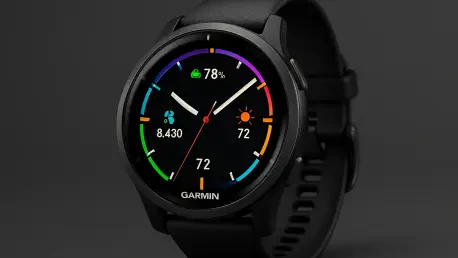In the ever-evolving world of wearable technology, finding a smartwatch that seamlessly blends premium design with practical fitness tracking remains a significant challenge for many active individuals who seek both style and substance. The Garmin Venu X1 Sports Smartwatch steps into this arena with bold promises, aiming to cater to both runners seeking robust performance metrics and casual users desiring a stylish, lifestyle-oriented device. This detailed exploration delves into the real-world capabilities of the Venu X1, assessing its strengths and shortcomings through the rigorous demands of running and daily wear. From its sleek build to its advanced features, the watch is put under the microscope to determine if it truly delivers on its hybrid appeal. As competition intensifies in the smartwatch market, understanding how this device balances aesthetics with functionality becomes crucial for potential buyers navigating their options.
I’m sorry, but it seems like there is no text provided for me to review or correct. If you have a specific piece of content or text you’d like me to assist with, please paste it here, and I’ll be happy to help with grammar, spelling, and style adjustments.
Design and Comfort
Design Aesthetics and Build Quality
The Garmin Venu X1 immediately captures attention with its premium construction, featuring sapphire glass and titanium that elevate its visual and tactile appeal to a level befitting a high-end device. At just 7.9mm thick and weighing a mere 34g (or 40g with the ComfortFit band), it stands out as one of the slimmer options in Garmin’s lineup, contrasting sharply with the often bulkier multisport watches. This thin profile and lightweight build suggest a focus on elegance, positioning the watch as a piece that can transition from gym to office with ease. However, the large 2-inch diagonal screen and wide case create a noticeable presence on the wrist, which might feel overpowering for some users. This design choice, while bold and modern, introduces a polarizing aspect, as it may appeal to those who favor a statement piece but could deter others seeking subtlety in their wearable tech.
Beyond the initial impression, the materials used in the Venu X1 speak to durability and sophistication, with the sapphire glass promising resistance to scratches and the titanium adding a touch of luxury without compromising on weight. Yet, this premium aesthetic comes with a trade-off, as the oversized case can dominate smaller wrists, making it less harmonious in fit compared to more compact alternatives. For runners or active individuals who prioritize a device that blends into their daily routine, this bulkiness might raise concerns about long-term comfort. The design, while undeniably striking, highlights a key tension between form and function that potential buyers must weigh, especially if wrist size or personal style plays a significant role in their decision-making process.
Fit and Wearability Challenges
When it comes to wearing the Venu X1 over extended periods, the fit becomes a critical factor that can sway user satisfaction, particularly during dynamic activities like running. The included Velcro band, intended to provide adjustability, often falls short by fitting too loosely even at its tightest setting, leading to a lack of security on the wrist. This issue is especially pronounced for users with narrower wrists, where the watch may shift or slide during movement, disrupting both comfort and data accuracy. Such a design flaw can be frustrating for runners who rely on a stable fit to ensure consistent sensor readings and to avoid distraction mid-stride, underscoring a gap between the watch’s premium intent and practical execution.
Additionally, the overall bulkiness of the case exacerbates wearability concerns, as the large dimensions can feel cumbersome during everyday tasks or intense workouts. While the lightweight nature of the materials helps mitigate some of this heft, the sheer size remains a barrier for those accustomed to slimmer, more unobtrusive devices. This aspect may not bother users with larger wrists or those who embrace a bolder look, but it risks alienating a significant portion of the market. For a smartwatch marketed to active individuals, addressing these fit challenges could be pivotal in broadening its appeal, as comfort over long durations often trumps aesthetic allure in the realm of fitness-focused wearables.
I’m sorry, but it seems there is no text provided for me to review or correct. If you have content you’d like me to assist with, please paste it here, and I’ll be happy to help with grammar, spelling, and style adjustments.
Display and Usability
AMOLED Screen Performance
One of the most striking features of the Venu X1 is its AMOLED display, which delivers a level of brightness, color saturation, and clarity that stands toe-to-toe with some of the best smartwatches on the market. Boasting a resolution of 448 x 486 pixels, the screen ensures that every detail—from workout stats to notifications—remains crisp and vivid, even under challenging conditions like direct sunlight or heavy rain. This exceptional visibility proves to be a game-changer for runners who need to glance at pace, distance, or heart rate data without breaking stride. The display’s ability to handle sweat and moisture without losing responsiveness further cements its reliability, making it a standout asset for outdoor activities where environmental factors often hinder lesser screens.
Moreover, the large size of the display enhances its practicality, allowing multiple data fields to be viewed simultaneously without feeling cramped or cluttered. This design choice caters directly to the needs of active users who require quick, at-a-glance information during workouts, reducing the frustration of navigating through menus or squinting at small text. Compared to other devices in Garmin’s portfolio, such as older Forerunner models with less vibrant screens, the Venu X1 offers a significant upgrade in readability. While this feature alone may not justify the watch’s premium price for everyone, it undeniably elevates the user experience, particularly for those prioritizing visual clarity in dynamic settings.
Navigation and Input System
Navigating the Venu X1 during a run or daily use reveals a thoughtful hybrid input system that combines a responsive touchscreen with two dedicated physical buttons, striking a balance between modern convenience and tactile reliability. The touchscreen proves intuitive and precise, allowing users to swipe through menus or tap to select options even when hands are sweaty or wet—an improvement over some earlier Garmin models that struggled with touch sensitivity. This responsiveness ensures that accessing key features like workout modes or notifications remains seamless, minimizing disruptions during high-intensity activities. For runners, this ease of interaction translates to less fiddling with the device and more focus on performance.
Complementing the touchscreen, the physical buttons—dedicated to start/stop and lap functions—add a layer of practicality that proves invaluable in scenarios where precision timing is essential. These buttons offer a satisfying click and can be operated without looking, which is a boon during fast-paced runs or when managing a stroller on uneven terrain. The synergy between touchscreen and buttons caters to varied user preferences, ensuring that whether one prefers digital swipes or traditional presses, the watch accommodates both. This versatility in navigation underscores the device’s aim to serve a broad audience, blending smartwatch sophistication with the functional demands of fitness tracking, though mastering the system might require a brief learning curve for first-time Garmin users.
I’m sorry, but it seems there is no text provided for me to review or correct. If you have content you’d like me to assist with, please include it, and I’ll be happy to help with grammar, spelling, and style adjustments.
Runner-Focused Features
Training Tools and Practical Features
For runners seeking a reliable companion on their training journeys, the Venu X1 offers a suite of features tailored to enhance both performance and safety, with some additions proving unexpectedly impactful. The built-in flashlight, for instance, emerges as a standout tool for night runs, casting sufficient illumination to spot obstacles like uneven pavement or curbs while also alerting others to the runner’s presence. This practical element addresses a common concern among evening exercisers, adding a layer of security that many fitness watches overlook. Beyond safety, the watch supports a range of workout modes and customizable data fields, allowing users to track metrics that matter most to their specific goals, whether it’s pace, distance, or calorie burn.
Another dimension of the Venu X1’s appeal for active users lies in its thoughtful integration of features that streamline the running experience without overwhelming with complexity. The ability to quickly start a workout or mark laps with dedicated buttons ensures that capturing split times or transitioning between activities happens effortlessly, even under physical strain. These tools, while not as extensive as those found in Garmin’s more specialized running watches, still provide a solid foundation for casual to intermediate runners. The flashlight and quick-access controls collectively position the device as a practical choice for those who value functionality during training, though advanced athletes might crave deeper analytical capabilities available in higher-end models.
Data Accessibility During Runs
Ensuring that critical data remains easily accessible during a run is a priority for any fitness-focused smartwatch, and the Venu X1 excels in this regard by leveraging its large, high-resolution display to present information with clarity. Metrics such as pace, heart rate, and distance are displayed in a legible format, minimizing the need to squint or adjust wrist position mid-stride—a common annoyance with smaller or less vibrant screens. This design proves particularly beneficial in dynamic scenarios, such as running with a stroller or navigating crowded paths, where maintaining focus on surroundings is as important as monitoring stats. The screen’s size allows for multiple data points to be viewed at once, reducing the need for excessive interaction with the device.
Furthermore, the responsive touchscreen enhances data accessibility by enabling swift navigation to additional screens or settings without fumbling, even when on the move. Runners can check split times or switch views with a quick swipe, preserving the flow of their workout. This seamless access to information is crucial for maintaining rhythm and making real-time adjustments, such as tweaking pace based on heart rate feedback. While the watch’s broader lifestyle focus means it may not offer the detailed customization of dedicated running devices, its ability to deliver essential data effectively caters to a wide range of active users. The emphasis on readability and interaction highlights a commitment to supporting runners in practical, meaningful ways.
I’m sorry, but it seems there is no content provided for me to review or correct. If you have text or a specific passage you’d like me to help with, please include it, and I’ll be happy to assist with grammar, spelling, and style adjustments.
Battery Life and Charging
Endurance with Key Features
Battery life often serves as a deciding factor for smartwatch users, and the Venu X1 presents a mixed picture that may influence purchase decisions depending on individual habits and needs. Garmin advertises up to eight days of usage in smartwatch mode without the always-on display (AOD) activated, a claim that holds up under minimal use conditions. However, enabling AOD—a feature many consider essential for instant time or data checks without wrist raises—drastically reduces this endurance. With AOD active and regular GPS tracking during runs, the battery often depletes to the point of needing a charge every two days, a frequency that can feel burdensome for users unaccustomed to frequent recharging routines.
This performance drop with key features enabled poses a challenge for those who rely on the watch for continuous monitoring or who lack consistent access to charging outlets, such as during travel or extended outdoor activities. While some users might adapt by toggling AOD off during less critical periods, this workaround undermines the seamless experience a premium device should offer. The battery’s limitations become particularly evident when compared to other Garmin models designed for longer endurance, raising questions about whether the Venu X1’s focus on display quality and hybrid functionality sacrifices too much in terms of staying power. For runners planning long sessions or multi-day events, this aspect requires careful consideration to ensure the watch aligns with their expectations.
Charging System Drawbacks
Beyond endurance, the charging experience of the Venu X1 introduces additional friction that can detract from overall user satisfaction, especially when compared to the more streamlined solutions offered by competitors. The proprietary charging cable, while functional, demands precise alignment to connect properly, often requiring extra fiddling compared to the magnetic or snap-on chargers found in devices like the Apple Watch. This minor inconvenience becomes more pronounced in hurried situations or low-light conditions, where securing the connection can test one’s patience. For a device at this price point, such design oversights stand out as missed opportunities to enhance ease of use.
Moreover, the lack of universal compatibility with standard charging solutions means users must carry the specific cable, adding an extra layer of planning for those on the go or prone to misplacing accessories. This contrasts with the growing trend of simplified, user-friendly charging systems in the smartwatch industry, where convenience often plays a significant role in daily usability. While the charging process itself is relatively quick once connected, the initial setup hassle could frustrate users who value efficiency. For active individuals who may need to recharge frequently due to heavy feature usage, these drawbacks in the charging system underscore a gap between the Venu X1’s premium aspirations and practical execution, potentially influencing long-term satisfaction.
I’m sorry, but it seems there is no text provided for me to review or correct. If you have content you’d like me to assist with, please include it, and I’ll be happy to help with grammar, spelling, or style adjustments.
GPS and Sensor Performance
Tracking Accuracy and Reliability
For runners, the accuracy of GPS and sensor data is non-negotiable, and the Venu X1 largely upholds Garmin’s reputation for dependable tracking, even without the dual-frequency GPS found in some competing or higher-end models. The watch quickly locks onto signals from major satellite networks, ensuring minimal delay before starting a run, which is a critical advantage for those eager to hit the road without waiting. On varied routes—whether suburban streets or winding trails—the device maintains solid accuracy, correctly mapping positions and handling sharp turns with commendable precision. Heart rate monitoring also proves reliable, delivering consistent readings during dynamic activities, a testament to the watch’s sensor quality despite its larger case size.
This level of performance instills confidence in users who rely on precise data to track progress or adjust training intensity, particularly for pace and distance metrics essential to structured workouts. While it may not reach the pinpoint accuracy of top-tier Garmin devices, the Venu X1 meets the needs of most casual to intermediate runners, offering a balance of speed and reliability in signal acquisition. Compared to some competitors at similar price points, the tracking holds up well, providing a stable foundation for fitness-focused activities. The consistency of these sensors ensures that the watch remains a trustworthy tool for monitoring performance, even if it doesn’t push the boundaries of cutting-edge GPS technology.
Limitations in Urban Settings
Despite its overall reliability, the Venu X1 encounters minor challenges in dense urban environments where tall buildings, bridges, and other obstructions can interfere with GPS signals, a common hurdle for devices lacking dual-frequency support. In such settings, occasional discrepancies in track fidelity may occur, with the watch sometimes struggling to maintain exact positioning amidst signal reflections or blockages. While these hiccups are not frequent enough to render the device unusable, they can be noticeable during runs through city centers, potentially affecting the accuracy of distance or pace data for users who train predominantly in metropolitan areas.
These limitations highlight a trade-off in the Venu X1’s design, where the absence of advanced GPS features—available in some competitors or Garmin’s pricier models—becomes more apparent under specific conditions. For runners who primarily navigate open or suburban routes, this drawback is unlikely to pose a significant issue, as the watch performs admirably in less obstructed spaces. However, urban dwellers or those frequently running in challenging signal environments may find the performance lacking compared to alternatives with enhanced capabilities. Setting realistic expectations about the device’s GPS behavior in such contexts is essential for potential buyers, ensuring alignment with their typical training landscapes and data accuracy needs.
I’m sorry, but it seems there is no text provided for me to review or correct. If you have content you’d like me to check for grammar, spelling, or style issues, please paste it here, and I’ll be happy to assist.
Competitive Positioning
Comparison to Apple Watch
When stacked against the Apple Watch Series 10, the Venu X1 holds its own in several key areas while revealing distinct gaps that reflect its hybrid nature. The AMOLED display matches or even surpasses the Apple Watch in brightness and outdoor visibility, offering runners a clear advantage for data readability during varied conditions. GPS reliability also edges out slightly, with the Venu X1 providing better track fidelity on most routes, a critical factor for fitness tracking precision. However, battery life with AOD enabled falls significantly short, often requiring more frequent charging than its competitor, which can be a drawback for users prioritizing endurance over aesthetics.
Additionally, the Venu X1 lacks certain smartwatch conveniences that the Apple Watch excels in, such as seamless text responses on iOS due to platform restrictions and the absence of cellular connectivity options. While it offers deeper fitness metrics tailored to active users, the ecosystem integration and polish of Apple’s offering remain unmatched, particularly for those already embedded in that tech environment. This comparison underscores the Venu X1’s strength in display and tracking but highlights compromises in broader functionality. For runners who value fitness over smart features, it presents a compelling alternative, though lifestyle users might find the Apple Watch’s versatility more aligned with their needs.
Comparison to Garmin Forerunner Series
Contrasting the Venu X1 with Garmin’s own Forerunner 265 and 570 models reveals a clear divergence in focus, with each line catering to different user priorities within the fitness realm. The Venu X1’s superior AMOLED display stands out as a significant upgrade over the Forerunners, providing unmatched clarity and vibrancy that enhances data visibility during runs. Its hybrid smartwatch appeal also brings a more polished, lifestyle-friendly design to the table, making it suitable for wear beyond training sessions. However, this comes at the cost of compactness, as the Forerunners are notably slimmer and better suited to smaller wrists, offering a less intrusive fit for daily use.
Battery endurance further differentiates these devices, with the Forerunner series often lasting longer under similar usage conditions, a crucial advantage for runners embarking on extended sessions or multi-day activities without access to charging. The Venu X1’s larger size and shorter battery life with AOD enabled may deter those who prioritize practicality over visual appeal, positioning the Forerunners as the go-to for dedicated athletes. While the Venu X1 appeals to a broader audience seeking a balance of style and function, the Forerunner line remains the better choice for pure running focus, illustrating how Garmin tailors its offerings to varied segments within the active community.
Market Fit and User Appeal
The Venu X1’s hybrid positioning between a fitness tracker and a lifestyle smartwatch creates a unique niche in a crowded market, appealing to users who desire versatility but potentially alienating those with more specific needs. Its premium build and stunning display cater to individuals who value aesthetics alongside functionality, making it an attractive option for casual runners or fitness enthusiasts who also want a device that complements their everyday style. This dual focus sets it apart from purely sport-oriented watches, offering features like notifications and a modern interface that enhance its role as an all-day companion.
However, this balance introduces trade-offs that may not resonate with everyone, particularly serious athletes who might find the lack of specialized running tools or extended battery life limiting compared to dedicated fitness watches. Similarly, tech-savvy users accustomed to deeply integrated smartwatch ecosystems might notice the absence of certain conveniences that competitors provide. The Venu X1 ultimately shines for those comfortable with its compromises, targeting a middle ground of users who prioritize a blend of form and function over niche excellence. Understanding this market fit is key for potential buyers, as it clarifies whether the watch’s strengths align with their lifestyle and activity demands, or if a more focused alternative would serve them better.
I’m sorry, but it seems like you’ve only provided a separator (“—“) without any content to review or correct. If you have specific text or content you’d like me to help with, please include it, and I’ll be happy to assist with grammar, spelling, or style corrections.
Reflecting on Smartwatch Trends
Balancing Hybrid Appeal
Looking back, the evaluation of the Garmin Venu X1 revealed a device that ambitiously straddled the line between a premium smartwatch and a fitness tracker, achieving notable successes while grappling with inherent compromises. Its exceptional AMOLED display and thoughtful runner-centric features, such as the practical flashlight, demonstrated a strong commitment to enhancing usability for active users. The reliable GPS and sensor performance further solidified its credibility as a training tool, even if urban environments occasionally tested its limits. Yet, the bulky design and fit issues, coupled with underwhelming battery life when using essential features, highlighted areas where the hybrid approach fell short of universal appeal.
Future Considerations for Users
Moving forward, potential buyers should weigh the Venu X1’s strengths against their personal priorities, considering whether the stunning visuals and versatile functionality outweigh the drawbacks of size and charging frequency. Exploring customization options for bands to improve fit or adopting power-saving habits, like toggling AOD selectively, could mitigate some limitations. For runners intrigued by this device, testing it in varied scenarios—both urban and open terrains—might provide clarity on its tracking reliability for their specific needs. As the smartwatch industry continues to evolve, keeping an eye on how Garmin addresses such trade-offs in future iterations could guide decisions, ensuring alignment with both current demands and emerging trends in wearable tech.









